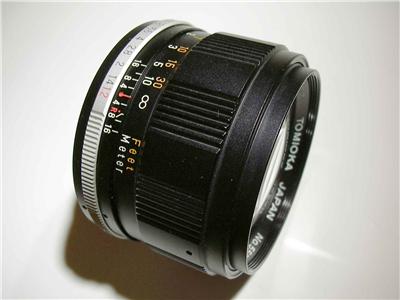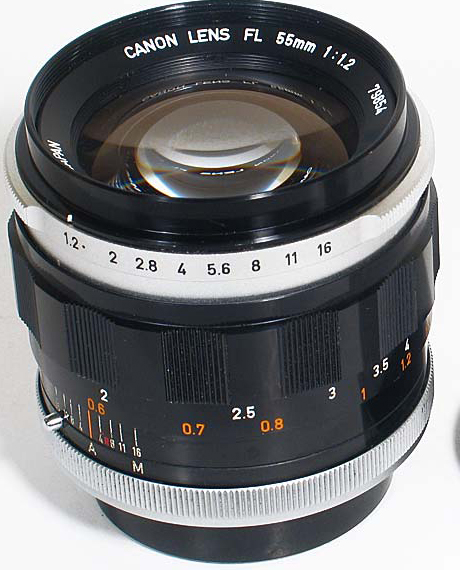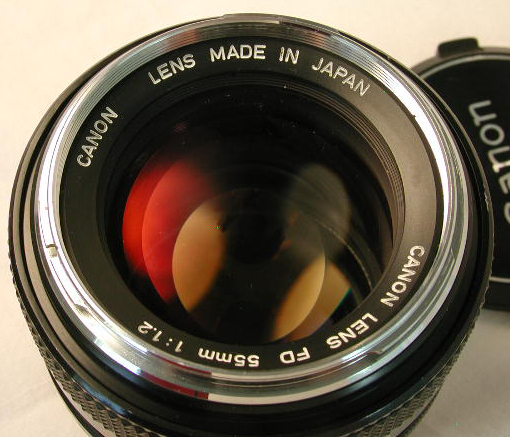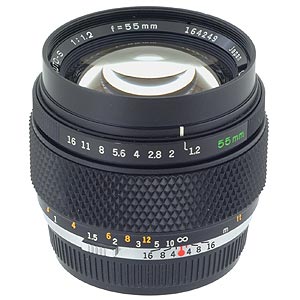Competitors of the Nikkor 1.2/55 mm. standard lens
The only manufacturers that introduced a standard lens with 1.2/55 mm. specifications were Canon and Olympus. Pentax and Minolta offered (since 1966) no 1.2/55mm. lenses but one with a focal length of 50 mm or 58 mm. in the late 1970's. Fuji introduced their fast Fujinon with a focal length of 56 mm. All others made use of a fast lens produced by Tomioka in Japan.
Tomioka Optical Company, founded in 1924, became member of Carl Zeiss Japan in 1974. It produced a very nice 1.2/55mm. lens in 42mm. screw mount (1971 - 1974) and so it did for well-known camera manufacturers like Chinon (founded in 1948 in Japan, since 2004 owned by Kodak Japan), - Auto Chinon Fuji (founded in 1934 as an offshoot of Dai-Nippon Celluloid, Japan), - Fujinon Cosina (founded in 1959 in Nagano, Japan; since 2005 partnership with Zeiss), - MC Cosinon Yashica (founded in 1945 in Japan and merged with Kyocera in 1983), - Auto Yashinon Riken Kankosh Co. (founded in 1936 in Japan), - Rikenon Vivitar (founded in Hollywood, USA in 1938 by Max Ponder and John Best; renamed in 1979 Vivitar, since 2008 owned by Sakar International) - Vivitar Series I - and camera distributors like Photo-Porst (brand name: Porst; - founded in 1919 by Hans Porst, Nuremberg, Germany) - Porst Color Reflex - and by Foto-Quelle (brand name: Revue; - founded in 1957 in Nuremberg, Germany and since 1970 the world's largest photographic retailer). - Auto Revuenon and Revuenon. The Tomioka design has 7 elements in 6 groups, a filter size of 55 mm. Due to production improvements there are some differences in performance. The brand name Tomioka disappeared after the take-over by Carl Zeiss in 1974.
Canon introduced the following fast lenses (after it already had a 1.2/58 mm. in R-mount since February 1962):
Left: Canon FL 1.2/55mm. - Right: Canon FD 1.2/55 mm.
Olympus offered in the late 1960's a G-Zuiko Auto-S 1.2/55 mm. having an optical formula of 7 elements in 6 groups, of which the second group from the front had a concave element! This lens can be focused down to 45 cm., has a filter size of 55 mm. and weighs 310 gr.
G-Zuiko Auto-S 1.2/55 mm.
All lenses mentioned here can be used wide open without any restrictions. Overall sharpness and contrast - however - will improve (in some cases dramatically) when the lens will be stopped down with one or two diaphragm stops. Most lenses are at their best a f/2.8 - f/5.6; at f/8 and smaller performance will decrease. Field curvature is evident full open, as well as depth of field. Even compared with the fast Nikkor it is difficult to announce a winner! Under very critical circumstances the aspherical Canon lenses may give better results.
|



